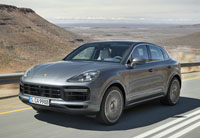
Ask anyone into cars which automaker makes the sportiest SUV, and Porsche will likely top the list more often than not. Whether we’re talking performance or styling, its Cayenne utility has long been considered one of the strongest performers in its mid-size luxury class, but that fact hasn’t stopped the German performance brand from producing an even sportier crossover model for 2020. Introducing the new Cayenne Coupé, a sharper more exciting version of the current Cayenne, designed to go head-to-head with the BMW X6s and Mercedes GLE Coupés of the world.
Before the Cayenne arrived on the global luxury SUV scene in 2002, BMW’s X5 was touted as the sportiest premium utility. The Cayenne, particularly in Turbo form, trounced all over the X5’s turf, but BMW arguably returned to the topmost podium spot when the X6 Sports Activity Coupé arrived in 2007.
With that sloped-back Bavarian SUV came a completely new niche market, solidified by the daringly different albeit mostly unloved (and therefore quickly cancelled) Acura ZDX in 2009, which was followed by the Mercedes-Benz GLE-Class Coupé in 2015, plus Lamborghini Urus in 2017 and Audi Q8 in 2018.
The latter two models, together with the Audi Q7, Bentley Bentayga, and Volkswagen Touareg, ride on VW group’s MLBevo platform, which is why it was only a matter of time before this Cayenne Coupé joined the fray. This said it’s quite possible for the new Porsche to earn even greater success than its familial rivals and other key competitors that came before, thanks to Porsche’s revered name and the model’s expected performance.
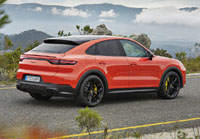
When compared to their regularly sized siblings, an obvious downfall of all SUV coupe competitors is practicality, the lower rooflines lending to less cargo capacity, and while this is as true of the Cayenne Coupé as it is with the X6 and more spacious X5, plenty of luxury car buyers not wanting a traditional family hauler are looking to this niche segment as a more pragmatic alternative to their current sport sedan or sports coupe. What’s more, the very existence of the new Cayenne Coupé allows Porsche to upsize future generations of the regular Cayenne, potentially even providing a three-row version to go up against the seven-passenger X5.
Changes from the redesigned 2019 Cayenne (which will remain unchanged for 2020) and the new Cayenne Coupé include a 20-millimetre lower roofline, including a new windscreen held up by shallower A pillars, plus narrower more pointed rear side windows, revised second-row doors skins, brand new rear quarter panels, and a reworked rear bumper, that last component now including an integrated license plate cutout. The new bodywork has resulted in 19 millimetres of increased width, which when combined with the Coupé’s lower ride height makes for a more aggressive stance overall.

Yet more Cayenne Coupé upgrades include a special adaptive rear deck lid spoiler, separated rear seats for a four-occupant total, plus two roof choices starting with a standard 2.16-cubic-metre fixed panoramic moonroof with sunshade, or an available carbon panel for an even sportier look.
That adaptive rear spoiler will be a first for the SUV coupe market segment, following in the footsteps of its bigger Cayenne brother in its more traditional mid-size luxury SUV category. The regular Cayenne uses an adaptive rooftop spoiler for its top-tier Turbo trim, whereas the active aerodynamic device will be standard on the new Cayenne Coupé, expanding by 135 mm (5.3 inches) when it reaches speeds of 90 km/h and beyond. Additionally, a rooftop spoiler pushes airflow down the sloping rear glass combines towards the active spoiler on the rear deck lid, further aiding the Coupé’s aerodynamics. This system, called Porsche Active Aerodynamics (PAA), increases downforce on the rear axle to provide better handling dynamics, while also improving high-speed efficiency to minimize wind noise and reduce fuel consumption.
By the way, the carbon roof mentioned earlier will require an upgrade to one of three lightweight sport packages, which also feature a number of Sport Design features, as well as unique 22-inch GT Design wheels, hounds-tooth Pepita checked fabric seat inserts that’ll send your memory back to classic 911s and 928s, plus carbon and microsuede-like Alcantara interior trim. What’s more, the new Cayenne Coupé Turbo includes a sport exhaust system as standard equipment.

The enhanced exhaust system connects through to the same twin-turbo 4.0-litre V8 as found in the regular Cayenne Turbo, capable of 541 horsepower and 567 pound-feet of torque, resulting in standstill to 100km/h in just 3.9 seconds. This means the new Cayenne Coupé Turbo’s standing start will only be improved upon by the previously noted 650-horsepower Lamborghini Urus, which hits 100km/h in only 3.6 seconds, which leaves the 567-horsepower X6 M and 577-horsepower AMG-Mercedes GLE 63 S Coupé requiring 4.2 seconds each to accomplish the same 100km/h run. Notably the smaller compact AMG-Mercedes GLC 63 S Coupé charges from naught to 100km/h in a scant 3.8 seconds thanks to its 503-horsepower V8, while the 503-horsepower BMW X4 M needs 4.1 seconds to achieve the same speed. Those that dare live on the edge can tout bragging rights to a 286-km/h top speed for the Cayenne Coupé Turbo, incidentally.
If ultimate speed isn’t your thing, and let’s face it, only those with a track nearby and enough time and money to rent it out for hot laps can take advantage without putting their license and new Cayenne Coupé Turbo in jeopardy, Porsche makes a less potent Cayenne Coupé available with an identical 335 horsepower turbocharged 3.0-litre V6 to the regular base Cayenne. This is where the new Audi Q8 fits into the scheme of things too, in case you were wondering, not to mention most of the above SUV coupes in their less formidable trims.
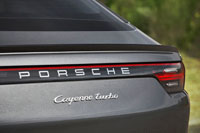
The turbocharged 3.0-litre V6 engine makes a healthy 335 horsepower and 332 lb-ft of torque, which is good enough for a 6.0-second sprint from zero to 100km/h in standard guise or 5.9 seconds when upgraded with one of its lightweight sports packages. The Sport Chrono Package, incidentally, is standard equipment with the Cayenne Coupé, which brings up an interesting point. When the regular base Cayenne is upfitted with its Sport Chrono Package, Porsche estimates its sprint time to 100km/h as 5.9 seconds, which strangely makes it 0.1 seconds faster to 100km/h than the new Cayenne Coupé. Additionally, the base Cayenne’s terminal velocity is 2 km/h faster at 245 km/h, the entry-level Cayenne Coupé’s only capable of 243 km/h. Are we making a mountain out a mole hill? Of course we are, but splitting such hairs is par for the course when it comes to this high-end, super-performance SUV arena, so we have every right to.
Back to standard equipment, the new Cayenne Coupé also gets speed-sensitive Power Steering Plus, Porsche Active Suspension Management (PASM), plus a set of 20-inch alloy rims, all of which will cause you to spend more when purchasing a regular Cayenne.
Now that we’re talking money, the new 2020 Cayenne Coupé will be available from just $86,400 when it goes on sale later this year, while the significantly quicker Cayenne Coupé Turbo will start at $148,000, plus freight and fees of course.
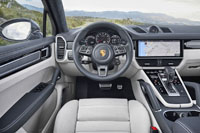
In its transformation from regular SUV to coupe, the new model also gets eight-way powered sport seats with beefier side bolsters, while passengers in back sit on cushions lowered by 30 mm (1.18 inches), allowing additional headroom to compensate for the lower rear roofline.
The Cayenne Coupé’s tapering roof negatively affects its load hauling ability too, but to be fair it’s only down by 145 litres (5.1 cubic feet) when compared to the normally sized Cayenne. To that end the base Coupé can manage up to 625 litres (22.0 cu ft) of gear behind its rear seats, whereas the bigger model is good for 770 litres (27.2 cu ft). When dropping the 40/20/40 split-folding rear row, luggage capacity increases to 1,540 litres (54.4 cu ft) compared to 1,710 litres (60.4 cu ft) in the regular Cayenne, which is a difference of only 170.0 litres (6.0 cu ft). Therefore, while not as practical as the regular Cayenne, the new Coupé should be just fine for those moving up from a sport coupe or sedan.
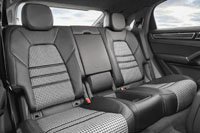
On that note, those considering moving over to the Cayenne Coupé from a second-generation Panamera will appreciate an extra 125 litres (4.4 cu ft) of cargo room when comparing base trims, while owners of the Panamera Sport Turismo will benefit by 105 litres (3.7 cu ft) of extra cargo volume.
Also important to note, the Cayenne Turbo Coupé’s cargo hold is 25 litres (0.9 litres) smaller than the base Cayenne Coupé at just 600 litres (21.2 cu ft) when the rear seats are in use, or by 30 litres (1.0 cu-ft) to 1,510 litres (53.3 cu ft) when they’re laid flat.
The all-new 2020 Cayenne Coupé will arrive across Canada this fall, but is available to preorder from your local Porsche retailer now.
Story credits: Trevor Hofmann
Photo credits: Porsche
